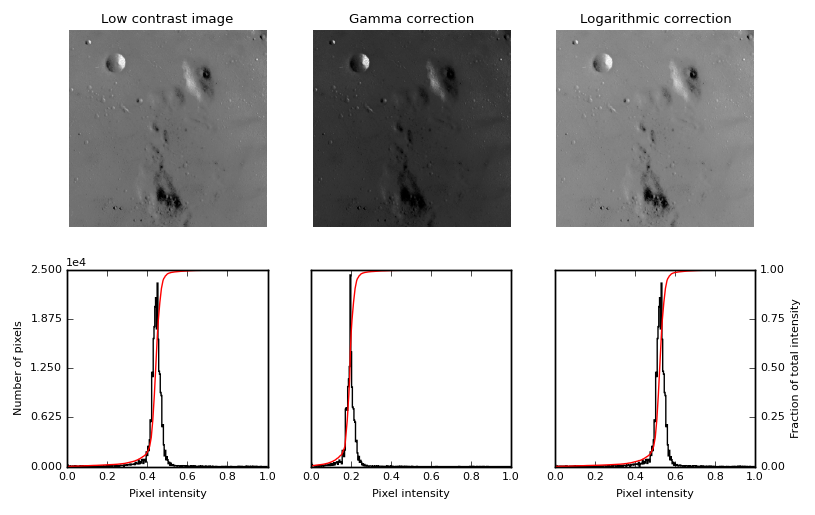python gamma矫正
发布时间:2019-09-22 07:53:49编辑:auto阅读(2607)
- 1
- 2
- 3
- 4
- 5
- 6
- 7
- 8
- 9
- 10
- 11
- 12
- 13
- 14
- 15
- 16
- 17
- 18
- 19
- 20
- 21
- 22
- 23
- 24
- 25
- 26
- 27
- 28
- 29
- 30
- 31
- 32
- 33
- 34
- 35
- 36
- 37
- 38
- 39
- 40
- 41
- 42
- 43
- 44
- 45
- 46
- 47
- 48
- 49
- 50
- 51
- 52
- 53
- 54
- 55
- 56
- 57
- 58
- 59
- 60
- 61
- 62
- 63
- 64
- 65
- 66
- 67
- 68
- 69
- 70
- 71
- 72
- 73
- 74
- 75
- 76
- 77
- 78
- 79
- 80
- 81
- 82
- 83
- 84
- 85
- 86
- 87
- 88
原文:http://blog.csdn.net/matrix_space/article/details/52415503
这个函数,主要用来做对比度调整,利用 gamma 曲线 或者 log 函数曲线,
gamma 函数的表达式:
y=xγ,
其中, x 是输入的像素值,取值范围为 [0−1], y 是输出的像素值,通过调整γ 值,改变图像的像素值的分布,进而改变图像的对比度。
log 函数的表达式:
y=alog(1+x), a 是一个放大系数,x 同样是输入的像素值,取值范围为 [0−1], y 是输出的像素值。
inverse log 的表达式:
y=a(2x−1),
这些变换都是从 [0−1] 变到 [0−1] 。
"""
=================================
Gamma and log contrast adjustment
=================================
This example adjusts image contrast by performing a Gamma and a Logarithmic
correction on the input image.
"""
import matplotlib
import matplotlib.pyplot as plt
import numpy as np
from skimage import data, img_as_float
from skimage import exposure
matplotlib.rcParams['font.size'] = 8
def plot_img_and_hist(img, axes, bins=256):
"""Plot an image along with its histogram and cumulative histogram.
"""
img = img_as_float(img)
ax_img, ax_hist = axes
ax_cdf = ax_hist.twinx()
# Display image
ax_img.imshow(img, cmap=plt.cm.gray)
ax_img.set_axis_off()
# Display histogram
ax_hist.hist(img.ravel(), bins=bins, histtype='step', color='black')
ax_hist.ticklabel_format(axis='y', style='scientific', scilimits=(0, 0))
ax_hist.set_xlabel('Pixel intensity')
ax_hist.set_xlim(0, 1)
ax_hist.set_yticks([])
# Display cumulative distribution
img_cdf, bins = exposure.cumulative_distribution(img, bins)
ax_cdf.plot(bins, img_cdf, 'r')
ax_cdf.set_yticks([])
return ax_img, ax_hist, ax_cdf
# Load an example image
img = data.moon()
# Gamma
gamma_corrected = exposure.adjust_gamma(img, 2)
# Logarithmic
logarithmic_corrected = exposure.adjust_log(img, 1)
# Display results
fig = plt.figure(figsize=(8, 5))
axes = np.zeros((2, 3), dtype=np.object)
axes[0, 0] = plt.subplot(2, 3, 1, adjustable='box-forced')
axes[0, 1] = plt.subplot(2, 3, 2, sharex=axes[0, 0], sharey=axes[0, 0],
adjustable='box-forced')
axes[0, 2] = plt.subplot(2, 3, 3, sharex=axes[0, 0], sharey=axes[0, 0],
adjustable='box-forced')
axes[1, 0] = plt.subplot(2, 3, 4)
axes[1, 1] = plt.subplot(2, 3, 5)
axes[1, 2] = plt.subplot(2, 3, 6)
ax_img, ax_hist, ax_cdf = plot_img_and_hist(img, axes[:, 0])
ax_img.set_title('Low contrast image')
y_min, y_max = ax_hist.get_ylim()
ax_hist.set_ylabel('Number of pixels')
ax_hist.set_yticks(np.linspace(0, y_max, 5))
ax_img, ax_hist, ax_cdf = plot_img_and_hist(gamma_corrected, axes[:, 1])
ax_img.set_title('Gamma correction')
ax_img, ax_hist, ax_cdf = plot_img_and_hist(logarithmic_corrected, axes[:, 2])
ax_img.set_title('Logarithmic correction')
ax_cdf.set_ylabel('Fraction of total intensity')
ax_cdf.set_yticks(np.linspace(0, 1, 5))
# prevent overlap of y-axis labels
fig.tight_layout()
plt.show()

上一篇: Python Flask开源博客系统Bl
下一篇: python optparse模块学习
- openvpn linux客户端使用
51787
- H3C基本命令大全
51475
- openvpn windows客户端使用
41877
- H3C IRF原理及 配置
38653
- Python exit()函数
33144
- openvpn mac客户端使用
30134
- python全系列官方中文文档
28808
- python 获取网卡实时流量
23801
- 1.常用turtle功能函数
23713
- python 获取Linux和Windows硬件信息
22084
- Ubuntu本地部署dots.ocr
154°
- Python搭建一个RAG系统(分片/检索/召回/重排序/生成)
2314°
- Browser-use:智能浏览器自动化(Web-Agent)
3007°
- 使用 LangChain 实现本地 Agent
2511°
- 使用 LangChain 构建本地 RAG 应用
2459°
- 使用LLaMA-Factory微调大模型的function calling能力
3089°
- 复现一个简单Agent系统
2460°
- LLaMA Factory-Lora微调实现声控语音多轮问答对话-1
3280°
- LLaMA Factory微调后的模型合并导出和部署-4
5398°
- LLaMA Factory微调模型的各种参数怎么设置-3
5213°
- 姓名:Run
- 职业:谜
- 邮箱:383697894@qq.com
- 定位:上海 · 松江
